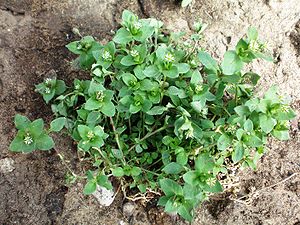Note: This is a project under development. The articles on this wiki are just being initiated and broadly incomplete. You can Help creating new pages.
Difference between revisions of "Stellaria media - Chickweed"
| Line 2: | Line 2: | ||
[[File:StellariaMedia001.JPG|thumb|right|''Stellaria media'', ''Chickweed'']] | [[File:StellariaMedia001.JPG|thumb|right|''Stellaria media'', ''Chickweed'']] | ||
| − | + | '''Stellaria media''', is a cool-season annual plant native to Europe, but naturalized in many parts of North America. | |
==Uses== | ==Uses== | ||
Revision as of 10:04, 10 June 2018
Stellaria media, is a cool-season annual plant native to Europe, but naturalized in many parts of North America.
Contents
- 1 Uses
- 2 Parts Used
- 3 Chemical Composition
- 4 Common names
- 5 Properties
- 6 Habit
- 7 Identification
- 8 List of Ayurvedic medicine in which the herb is used
- 9 Where to get the saplings
- 10 Mode of Propagation
- 11 How to plant/cultivate
- 12 Commonly seen growing in areas
- 13 Photo Gallery
- 14 References
- 15 External Links
Uses
bronchitis, pleurisy, gastritis, asthma, sore throat, boils, wounds, itching, hemorrhoids
Parts Used
Chemical Composition
The anthraquinones emodin, parietin (physcion) and questin, the flavonoid kaempferol-3,7-O-α-L-dirhamnoside, the phytosterols β-sitosterol and daucosterol, and the fatty alcohol 1-hexacosanol can be found in S. media.[12] Other flavonoid constituents are apigenin 6-C-beta-D-galactopyranosyl-8-C-alpha-L-arabinopyranoside, apigenin 6-C-alpha-L-arabinopyranosyl-8-C-beta-D-galactopyranoside, apigenin 6-C-beta-D-galactopyranosyl-8-C-beta-L-arabinopyranoside, apigenin 6-C-beta-D-glucopyranosyl-8-C-beta-D-galactopyranoside, apigenin 6, 8-di-C-alpha-L-arabinopyranoside[1]
Common names
| Language | Common name |
|---|---|
| Kannada | |
| Hindi | Buch-bucha |
| Malayalam | |
| Tamil | |
| Telugu | |
| Marathi | NA |
| Gujarathi | NA |
| Punjabi | NA |
| Kashmiri | NA |
| Sanskrit | |
| English | chickweed |
Properties
Reference: Dravya - Substance, Rasa - Taste, Guna - Qualities, Veerya - Potency, Vipaka - Post-digesion effect, Karma - Pharmacological activity, Prabhava - Therepeutics.
Dravya
Rasa
Guna
Veerya
Vipaka
Karma
Prabhava
Habit
Identification
Leaf
| Kind | Shape | Feature |
|---|---|---|
| Simple | oval | Chickweed leaves are oval with pointed tips that are smooth or slightly hairy |
Flower
| Type | Size | Color and composition | Stamen | More information |
|---|---|---|---|---|
| Unisexual | small | white | 5 petals | these are produced at the tips of stems and in angles between branches |
Fruit
| Type | Size | Mass | Appearance | Seeds | More information |
|---|---|---|---|---|---|
| oval | An oval, one-celled capsule, whitish in color, containing numerous seeds | whitish | numerous seeds | {{{6}}} |
Other features
List of Ayurvedic medicine in which the herb is used
- Vishatinduka Taila as root juice extract
Where to get the saplings
Mode of Propagation
How to plant/cultivate
A very easily grown plant, it prefers a moist soil and a position in full sun or partial shade[3]
Commonly seen growing in areas
lawns, cultivated fields, pastures.
Photo Gallery
References
External Links
- Ayurvedic Herbs known to be helpful to treat bronchitis
- Ayurvedic Herbs known to be helpful to treat pleurisy
- Ayurvedic Herbs known to be helpful to treat gastritis
- Ayurvedic Herbs known to be helpful to treat asthma
- Ayurvedic Herbs known to be helpful to treat sore throat
- Ayurvedic Herbs known to be helpful to treat boils
- Ayurvedic Herbs known to be helpful to treat wounds
- Ayurvedic Herbs known to be helpful to treat itching
- Ayurvedic Herbs known to be helpful to treat hemorrhoids
- Herbs with Seeds used in medicine
- Herbs with Leaves used in medicine
- Herbs with common name in Hindi
- Herbs with common name in English
- Habit - Herb
- Index of Plants which can be propagated by Seeds
- Herbs that are commonly seen in the region of lawns
- Herbs that are commonly seen in the region of cultivated fields
- Herbs that are commonly seen in the region of pastures
- Herbs







